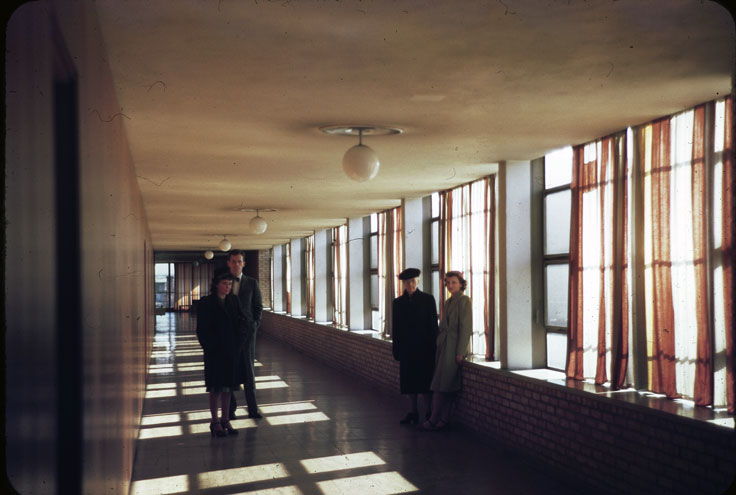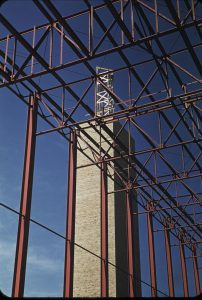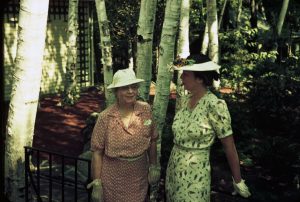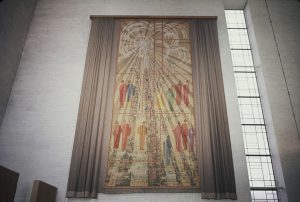
Plan your visit
Celebrating Design Month, Part 1
October 2, 2018

In celebration of Design Month, we are sharing stories from our Collections centering on Mid-Century Modern design in Central Indiana. First up, a little discussed facet of the story of the building that started Columbus’ association with modern architecture, First Christian Church.

First Christian Church construction in progress, circa 1940
Although the names J. Irwin and Xenia Miller are synonymous in Columbus with their patronage of modern art, design and architecture, it should be noted that the Saarinen design for First Christian Church was subtly promoted and nurtured by Nettie Sweeney Miller, J. Irwin Miller’s mother. While it was J. Irwin Miller who, after taking an architecture appreciation class at Yale, suggested that the Irwin-Sweeney-Miller family consider ditching a traditional church design for a modern one, according to Elsie Irwin Sweeney’s recollections, it was Nettie who suggested Eliel Saarinen as the man for the job. He came recommended by a woman in Nettie’s Sunday School class whose son was married to the daughter of Saarinen’s contractor, A.C. Wermuth. It was Nettie who, as a member of the church building committee, went to Detroit to interview Saarinen, where they both agreed that a church should not be theatrical, but instead should be beautiful, timeless, humble and reverential.

Nettie Sweeney Miller with her daughter, Clementine Miller Tangeman, circa 1940s
Nettie’s hand in supporting Saarinen’s vision is apparent in the correspondence between her and her daughter Clementine over both the summer of 1940 and 1941, when Clementine seemed to be acting as Nettie’s ears on the ground in Columbus while Nettie took up her summer residence in Muskoka, Canada. In July 1940, Clementine writes of the concerns that rest of the family had with the finances for the building project, “I can see trouble brewing on the church horizon.” She continues to report that “Mr. S. says he wishes Mother were here to handle Uncle [William G. Irwin],” which gives the initial indication that it was Nettie who was the steadfast support for continuing to move ahead on the plans to complete the church. The next summer, in 1941, Nettie writes to Clementine, again from Muskoka, addressing the continued concerns over the church and trying to soothe ruffled feathers. “The church will be all right though. Eliel Saarinen’s forte is functional architecture and he will make that just right.” Later on in the month, she checks in with Clementine to offer her opinion about the type of glass that will go in the church window as well as to discuss the options for the way the tapestry will be hung, and asks that Clementine relay her wishes to Mr. Wermuth and Mr. Saarinen. Further on in the letter, she comments that she is relieved that the family members in Columbus seem pleased with the way construction is shaping up. “I am so delighted to know that you are pleased with the church since the scaffolding has been taken town. Your father was very doubtful about that. He did not know whether he was going to like it or not.”

Tapestry designed by Loja Saarinen that hangs in First Christian Church
Thanks in part to Nettie’s belief and assurances, today the unmistakable, mostly unadorned campanile of First Christian rises tall above the seemingly endless sight lines of Central Indiana as one enters the city of Columbus, a harbinger of modern treasures that later began to dot the landscape.
For more Mid-Century Modern stories, please visit us at the William H. Smith Memorial Library classroom for a show-and-tell on Saturday, Oct.6, at 1 p.m. and follow along on the blog for the month of October.









